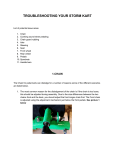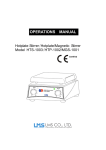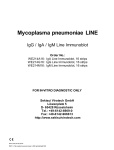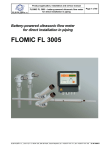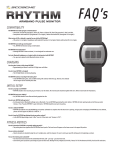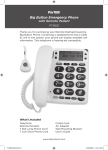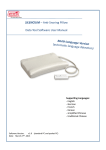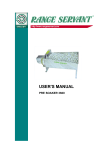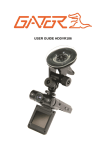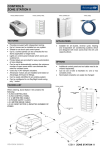Download User Manual - US . Home/Self Use
Transcript
HOME/SELF USE User Manual US English Alarm unit & Sensor patch Instructions for use Alarm unit & Sensor patch US English version © 2010 Redsense Medical AB P.O Box 287 SE-301 07 Halmstad www.redsensemedical.com Redsense Medical INC 150 N. Michigan Avenue, Suite 1950 Chicago, IL 60601, US Phone: +1 877 733 0830 Fax: +1 312 276 8606 RM-1-RM129 July 2010 Caution: Federal (US) law restricts this device to sale by or on the order of a licensed practitioner. Instructions for use Warnings and Precautions About the Redsense alarm system Setting up Redsense While dialysis is in progress After the dialysis is complete Maintenance Cleaning Charging the battery Changing the battery Figures 2-7 Figures 8-13 Figures 14-17 Symbols and terms 3 3 4 4 5 5 5 5 5 6 7 8 9 Intended use The Redsense device is intended to monitor for potential blood loss from the hemodialysis access site in hemodialysis patients undergoing hemodialysis treatment up to 5 hours at home or in the clinical setting. The device includes a blood sensor incorporated into an adhesive dressing. The sensor monitors potential blood leakage from the needle puncture via an infrared light and will alarm if needle dislodgement or blood leakage is detected. All use must be administrated under physician’s prescription, and must be observed by a trained and qualified person considered to be competent in the use of this device by the prescribing physician. Instructions for use Alarm unit & Sensor patch 02 Warnings and Precautions About the Redsense alarm system • The Redsense - device is intended to monitor for potential blood loss from the hemodialysis access site in hemodialysis patients undergoing hemodialysis treatment up to 5 hours at home or in the clinical setting. Redsense is a system for monitoring the vein needle during hemodialysis. Redsense consists of an alarm unit and a sensor patch (see Fig. 1). Once the sensor patch has been placed over the vein needle it detects blood that comes into contact with the sensor patch. This can occur if the needle has been accidentally pulled out or if there is a blood loss during dialysis. • The device includes a blood sensor incorporated into an adhesive dressing. The sensor monitors potential blood leakage from the needle puncture via an infrared light and will alarm if needle dislodgement or blood leakage is detected. • All use must be administrated under physician’s prescription, and the patient using the device at home must be considered to be competent in the use of this device by the prescribing physician. FIG. 1 Alarm unit • All use must be observed by a trained and qualified person, considered to be competent in the use of this device by the prescribing physician. • Before use a test must be performed to make sure the patient and the observing person can clearly hear the alarm signal. The test is further described at page 6 under point 9. • Redsense must be used only for its intended purpose and in accordance with these instructions. All other use is not allowed. • The device must only be attached to the patient as shown in instruction for use and the user manual. • Read and follow all instructions for use carefully. Sensor patch • Redsense has been tested and is approved in accor dance with the IEC 60601-1-2:2007 and IEC 610006-1:2007 standard concerning electromagnetic compatibility (EMC). Redsense requires special precautions regarding EMC and consequently has to be employed in conformance with the EMC information detailed in these instructions. Portable and mobile RF communications equipment may affect Redsense. • This device should not be relied upon as the sole monitor for blood loss/needle disconnection at the vascular access site. Warnings and Precautions • Redsense is not for nocturnal use. Instructions for use Alarm unit & Sensor patch 03 Setting up Redsense Redsense should be placed on your arm after the insertion of the needles and prior to the start of dialysis. Redsense must be switched on for the entire duration of the dialysis. The alarm unit can be fasten as follows: Fasten the alarm unit with the clip at a maximum distance of 25 cm from the needle with the sockets turned towards the sensor patch. You can also fasten the alarm unit with a Velcro strip which is optional. Fig. 2 shows the alarm unit fastened onto the upper arm with the clip. It is also possible to fasten the alarm unit onto the lower arm and turn it to face in the opposite direction. Fig. 3 shows the alarm unit fastened onto the upper arm using the Velcro strip. Do not tighten the Velcro strip too hard due to possible compression of access vessels. It is also possible to fasten the alarm unit to your shirt pocket. 1. Fasten the Velcro strip to your upper or lower arm if the Velcro strip is being used. 2. Remove the sensor patch from its pack Fig. 4 The sensor patch must be labelled “Redsense”. Ensure that the sensor patch is not mechanically damaged. 3. Completely clean the area around the needle so that any fluid, blood, residual cleaning fluid, lotion, etc. is fully removed. 4. Apply the sensor patch to the skin over the needle with the absorbent part of the patch centered over the puncture Fig. 5. Make certain that the sticky part of the patch does not cover the wings. Fig. 6 shows how the sensor should be placed in position. 5. Fasten the needles in place in the normal way by using tape or something equivalent. 6. Connect the sensor patch cable to the alarm unit by pressing the connector into the socket until a click is heard (Fig. 7 & Fig. 8). For use with upper arm fistula see Fig. 9. 7. Fasten the alarm unit with the clip (Fig. 10). For use with upper arm fistula see Fig. 11. 8. If necessary, tape can be used to stick the sensor patch and/or the sensor cable down. Fig. 12-13 show how the fibre optic cables of the sensor patch can be fastened to your arm. 9. Press the on button once to start the test of the alarm signal and the 4 LED. (Fig. 14-15) Confirm that all 4 LED are lit and clearly can be indicated. Confirm that the patient and the observing person can clearly hear the alarm signal. The observing person must be sure that the alarm signal can be heard from other rooms or while there is noise in the house. The observing person must be situated at places where the alarm signal can be heard during the entire dialysis treatment. The alarm signal test will continue until the button is pressed again. 10. To stop the test of the LED and alarm signal press the start button once again. The green light starts to blink for a few seconds before becoming completely lit. When the green light is completely lit, the alarm is operational, the monitoring is functioning in the correct way and the dialysis can begin. The green light blinking indicates that the alarm unit is performing a test. During this test there are three conditions that may need to be addressed. These are shown by the following lights and symbols being illuminated: • The yellow light, marked by the battery symbol, denotes that the battery does not have sufficient capacity left for a 5 hours dialysis session and should be recharged. See the later section on maintenance about charging the battery. • The yellow light, marked by a warning symbol signifies one of the following situations: There is moisture on the sensor. The sensor is not correctly connected. The sensor is defect. • If all LEDs are blinking this means that an internal software error has been detected, please contact Redsense Medical for further support. Any problems should be dealt with before a new attempt is made to start the alarm unit. If blood or moisture has come into contact with the sensor, it must be replaced by a new one. If any other technical problem appears do not use the Redsense unit, please contact Redsense Medical for further support. While dialysis is in progress During operation the green light is completely lit and you may observe the following: • The red light accompanied by a continuous two-toned alarm signal indicates that blood has dripped onto the sensor either because the needle has been pulled out or there has been a leakage. In this event, firstly, deal with the reason for the leakage and then switch off the alarm by holding the button pressed in for one second. • The yellow battery warning light accompanied by an intermittent alarm signal signifies that the battery capacity has become too low meaning that the monitoring can no longer be performed correctly. In this case, switch off the alarm unit by pressing and holding in the button and then replace it with a fully-charged unit. • The yellow warning light accompanied by an intermit tent alarm signal indicates one of the following: Moisture has come into contact with the sensor. The sensor has come loose or broken down. Instructions for use Alarm unit & Sensor patch 04 While dialysis is in progress (cont.) Charging the battery Switch off the alarm by holding the button pressed in and continue the dialysis without monitoring the needle or change to a new sensor patch and start again. The battery should only be charged when the alarm unit is not in use and is not attached to your arm. A fully-charged battery lasts 15-20 hours meaning that it is advisable to charge the battery after each dialysis treatment, depending on the duration of the treatment. • All LEDs blinking accompanied by an intermittent alarm signal indicates an internal software error, please contact Redsense Medical for further support. Switch off the alarm unit by holding the button pressed in and continue the dialysis without monitoring the needle, please contact Redsense Medical for further support. 1. Connect the charger to the alarm unit using the cable. The charger must be labeled “Redsense”. Note that the sensor should not be connected at the same time (Fig.17). 2. Plug the charger into a socket outlet (100 - 240 V). After the dialysis is complete 3. The yellow light blinks while charging is in progress. 1. Hold the button pressed down for one second in order to switch off the alarm. 2. Remove the sensor patch from your arm. 4. When the green light is illuminated, the battery is fully charged. This can take up to 6 hours. 3. Remove the alarm unit. 4. Disconnect the sensor patch from the alarm unit and dispose it along with the other waste material from the dialysis. 5. Clean the alarm unit according to the maintenance instructions. Note: The alarm can also be switched off at any time during an ongoing dialysis. Maintenance Cleaning The sensor patch itself is disposable and must not be cleaned for re-use. Changing the battery In order to change the battery, the alarm unit must be opened up and therefore this should only be done when the unit is being serviced. Service must be performed by personnel authorized by Redsense Medical. Internal memory Redsense alarm unit has an internal memory that stores data on the last treatments. The internal memory is accessed using the communications port. The internal memory must only be accessed by personnel authorized by Redsense Medical. The alarm unit should be wiped off with appropriate disinfectant after every use. Either an alcohol based disinfectant, using a slightly damp cloth, or pads saturated with alcohol based disinfectant can be used. If blood has come into contact with the alarm unit, the unit must be cleaned carefully to avoid biohazards. DO NOT use Alcalic detergents as they may damage the plastic shell of the alarm unit. If using the Velcro strip, the Velcro strip is personal and must only be used by you. Printable surface If any kind of information needs to be written on the alarm unit Fig. 16 shows the surface intended for this purpose. Use a marker or similar. If the written information needs to be removed or changed it can be wiped off using a damp cloth dipped in alcohol. Instructions for use Alarm unit & Sensor patch 05 Setting up Redsense Fig 2-7 FIG. 3 FIG. 2 FIG. 4 FIG. 5 YES YES FIG. 6 NO FIG. 7 Instructions for use Alarm unit & Sensor patch 06 Setting up Redsense Fig 8-13 FIG. 8 FIG. 9 FIG. 10 FIG. 11 FIG. 12 FIG. 13 Instructions for use Alarm unit & Sensor patch 07 Setting up Redsense Fig 14-17 FIG. 14 FIG. 15 FIG. 16 FIG. 17 Printable surface Instructions for use Alarm unit & Sensor patch 08 Symbols & terms The following symbols and terms are used in this manual and on the product: Red light and alarm symbol On / off button Communications port Yellow light and battery symbol Green light and working symbol Yellow light and warning symbol Socket for the sensor fiber optic cable Socket for battery charger Other symbols displayed on the product and its accessories indicate the following: The product fulfills the requirements in 93/42 EEC (Medical Device Directive) Lot number including year of manufacture (Sensor patch) Consult Instructions for use User part Type BF- Body Floating (the surface between the device and the patient does not conduct electricity) Redsense Medical AB Halmstad Sweden The alarm unit is covered by the WEEE directive, therefore it must be recycled. (Alarm unit) Manufactured by Redsense Medical AB Sweden Only for single use (Sensor patch) Last date for use of the sensor. In this example year 2008 month 9. (Sensor patch) EXP. 2008-09 Serial number, including year of manufacture (Alarm unit) STERILE EO The sensor has been sterilized using Ethylene Oxide (Sensor patch). Instructions for use Alarm unit & Sensor patch 09









